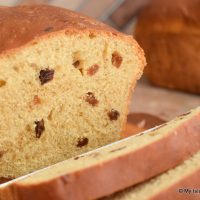Print


Old-fashioned Raisin Bread
Plump raisins and the warm spices of cinnamon and nutmeg join forces to make this superb Raisin Bread with its soft, chewy texture and fragrant scent. Makes great toast and wonderful French Toast
Ingredients
- ¾ cup milk (no less than 2%M.F.)
- ¾ cup warm water (110°F)
- 2½ tbsp molasses
- 1/3 cup + 1 tbsp brown sugar, packed
- 3 tbsp butter, room temperature
- ½ tbsp salt
- 1 tsp cinnamon
- ½ tsp nutmeg
- 1 large egg, room temperature, lightly beaten
- ½ cup warm water (110°F)
- 1 tsp granulated sugar
- 1 tbsp + 1 tsp traditional active dry yeast
- 1¾ cups raisins
- 5 – 5½ cups bread flour (*see note below)
- 2 tsp butter, room temperature, for greasing tops of loaves (optional)
- Cooking oil (for hands when kneading dough)
Instructions
-
Assemble and measure out all ingredients before beginning.
-
In medium-sized saucepan, over medium-high heat, bring milk to the scalding point (180°F), stirring frequently to prevent milk from scorching. Do not boil the milk. Remove from heat and stir in the warm water, molasses, brown sugar, butter, salt, cinnamon, and nutmeg. Stir until sugar has dissolved and butter has melted. Let mixture cool to about 110°F then whisk in the lightly beaten egg.
-
While the milk mixture is cooling, place ½ cup warm water (110°F) in large 2-cup measuring cup or bowl. Stir 1 tsp sugar into the warm water until sugar is dissolved. Sprinkle yeast over the water and quickly, but gently, stir in the yeast. Let yeast stand, undisturbed with no stirring, for about 10-12 minutes, or until yeast is foamy and bubbly. Stir down yeast.
-
In bowl of stand mixer fitted with dough hook, combine the liquid ingredients with the yeast along with 2 cups of the flour gradually added, one cup at a time. Beat on slow speed to blend ingredients then increase speed to medium (e.g., the “6” setting on KitchenAid Classic mixer) and beat for 1 minute. Scrape the bowl to ensure all ingredients are incorporated. Add the raisins. Again, with mixer on slow speed, gradually add 2 more cups of flour, about a cup at a time. Increase speed to medium and beat mixture for 1 minute. Transfer mixture to a lightly floured surface, using some of the remaining flour to flour the work surface. With hands greased with a small amount of vegetable oil, begin kneading the dough by hand, continuing to add more of the flour called for in the recipe until the dough is smooth, elastic, and pliable, about 8-10 minutes. Periodically re-grease hands with the oil as necessary to prevent them from sticking to the dough. (Note: If you have a very large mixer, the dough could be completely kneaded by mixer; however, if you have a standard-sized stand mixer, it will be difficult to get the dough perfectly kneaded by mixer with the quantity of flour called for in this recipe).
-
Grease a bowl large enough to allow the dough to double in size. Grease all sides of dough with vegetable oil to prevent it from drying out and transfer dough to prepared bowl. Cover the top of the bowl loosely with plastic wrap that has been sprayed with cooking oil. Cover bowl completely with a towel or lightweight blanket and place in warm, draft-free location to rise until dough doubles in size, about 1¼ - 1¾ hours.
-
Prepare two 9”x5”x3” loaf pans by greasing all sides of pans.
-
Using vegetable oil, grease the work surface. Punch down dough in bowl with fist and turn dough out onto greased surface. Divide dough into two equal portions.
-
Shape each portion of dough into an oval loaf shape and place in prepared pans.
-
Cover loaves loosely with a tea towel and place in warm, draft-free location to rise again for between 45 and 60 minutes.
-
About 20 minutes before bread is expected to be ready to be baked, preheat oven to 350°F. Transfer bread to oven and bake for 30-35 minutes, or until bread is nicely browned on top and loaves sound hollow when tapped. Immediately transfer bread from pans to wire racks to cool. If desired, gently grease tops of the hot bread with butter. Cool bread completely before cutting and serving.
Recipe Notes
Copyright My Island Bistro Kitchen 2020
Yield: 2 loaves
Note: Bread flour is recommended for this recipe; however, all-purpose flour may be substituted (cup-for-cup) for the bread flour. Results may differ with substituted flour product – see accompanying blog post for details and explanation.